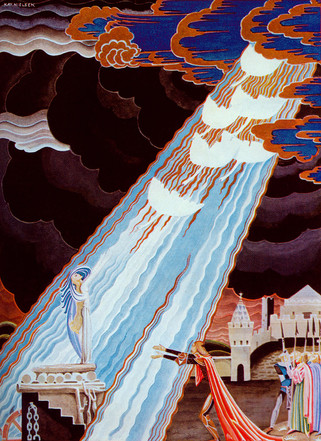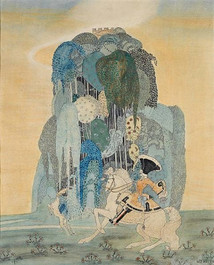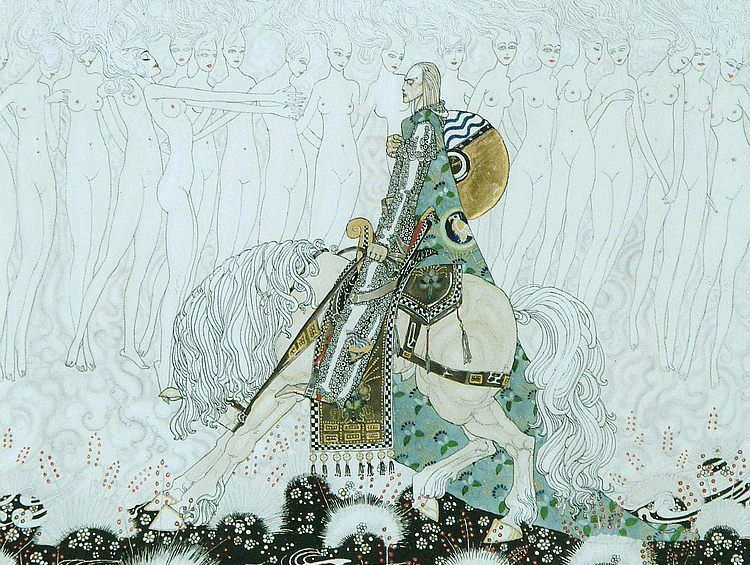Kay Nielsen - Gifted Gallery
- Lilium

- Apr 4, 2021
- 4 min read

Kay Rasmus Nielsen, born 12 March 1886, was a Danish illustrator who was popular in the early 20th century, the "golden age of illustration" which lasted from when pioneers developed printing technology to the point that drawings and paintings could be reproduced with reasonable facility.
Kay Nielsen was born in Copenhagen into an artistic family; both of his parents were actors - Nielsen's father, Martinius Nielsen, was the director of Dagmarteater and his mother, Oda Nielsen, was one of the most celebrated actresses of her time, both at the Royal Danish Theater and at the Dagmarteater. Nielsen studied art in Paris at Académie Julian and Académie Colarossi from 1904 to 1911, and then lived in England from 1911 to 1916.
Nielsen received his first English commission from Hodder and Stoughton to illustrate a collection of fairy tales, providing 24 colour plates and more than 15 monotone illustrations for In Powder and Crinoline, Fairy Tales Retold by Sir Arthur Quiller-Couch in 1913. In the same year, Nielsen was also commissioned by The Illustrated London News to produce a set of four illustrations to accompany the tales of Charles Perrault; Nielsen's illustrations for 'Sleeping Beauty', 'Puss in Boots', 'Cinderella' and 'Bluebeard' were published in the 1913 Christmas Edition.
A year later in 1914, Nielsen provided 25 colour plates and more than 21 monotone images for the children's collection East of the Sun and West of the Moon. The colour images for both In Powder and Crinoline and East of the Sun and West of the Moon were reproduced by a 4-colour process, in contrast to many of the illustrations prepared by his contemporaries that characteristically utilized a traditional 3-colour process. Also in that year, Nielsen produced at least three illustrations depicting scenes from the life of Joan of Arc. When published later in the 1920s, these images were associated with relevant text from The Monk of Fife.
While painting landscapes in the Dover area, Nielsen came into contact with The Society of Tempera Painters where he learned new skills, and was able to reduce the time involved in the painting process. In 1917 Nielsen left for New York where an exhibition of his work was held and subsequently returned to Denmark. Together with a collaborator, Johannes Poulsen, he painted stage scenery for the Royal Danish Theatre in Copenhagen.
During this time, Nielsen also worked on an extensive suite of illustrations intended to accompany a translation of The Arabian Nights that had been undertaken by the Arabic scholar, Professor Arthur Christensen. According to Nielsen's own published comments, these illustrations were to be the basis of his return to book illustrations following a hiatus during World War I and the intention had been to publish the Danish version in parallel with versions for the English-speaking world and the French market. The project never came to fruition and Nielsen's illustrations remained unknown until many years after his death.
During the 1920s, Nielsen returned to stagecraft in Copenhagen designing sets and costumes for professional theatre. During that time, at age 40, he married the charismatic 22-year-old Ulla Pless-Schmidt, daughter of a wealthy physician, and they became a devoted couple. At this point, he was Scandinavia's most famous artist.
Following his theatrical work in Copenhagen, Nielsen returned to contributing to illustrated books with the publication of Fairy Tales by Hans Andersen in 1924. That title included 12 colour plates and more than 40 monotone illustrations. The colour images were prepared with integrated formal and informal borders; the informal borders were produced in a mille fleur style.
A year later, Nielsen provided the artwork for Hansel and Gretel, and Other Stories by the Brothers Grimm which was first published with 12 colour images and over 20 detailed monotone illustrations.
A further 5 years passed before the publication of Red Magic, the final title to be illustrated comprehensively by Nielsen. The 1930 version of Red Magic included 8 colour and more than 50 monotone contributions from the Danish artist.
In 1937 Nielsen left for California and worked for Hollywood companies. His work was used in the Night on Bald Mountain /Ave Maria sequences of Fantasia. Nielsen was renowned at the Disney studio for his concept art and he contributed artwork for many Disney films, including concept paintings for a proposed adaptation of Hans Christian Andersen's The Little Mermaid. Nielsen worked for The Walt Disney Company for 4 years, from 1937 to 1941 before being let go.
Nielsen briefly returned to Denmark in desperation. However, he found his works no longer in demand there either. His final years were spent in poverty. His last works were for local schools, including 'The First Spring' mural installed at Central Junior High School, Los Angeles and churches, including his painting to the Wong Chapel at the First Congregational Church, Los Angeles, illustrating the 23rd Psalm.

A heavy smoker, Nielsen contracted a chronic cough that would plague him until his death on June 21, 1957 at the age of 71. His funeral service was held under his mural in the Wong Chapel. His wife, Ulla, died the following year.
Before her death Ulla gave Nielsen's remaining illustrations to fellow artist and architect Frederick Monhoff, who in turn tried to place them in museums. However, none – American or Danish – would accept them at the time.
Nielsen has since gained recognition notably for his masterpiece East of the Sun and West of the Moon, Old Tales from the North (1914), the collection of Norwegian fairy tales. Many exhibitions of his work have been held, the most recent at the time of writing this article was at the Museum of Fine Arts in Boston, which opened Kay Nielsen’s Enchanted Vision: The Kendra and Allan Daniel Collection. One curator described the experience of putting together the exhibition: “Nielsen’s illustrations are mesmerising when seen in print...breathtaking with their powerful imagery and extraordinary detail."
Reading Recommendations & Content Considerations
Old Tales from the North Illustrated by
Kay Nielsen Kay Nielsen

















































































































































































































































































































Comments